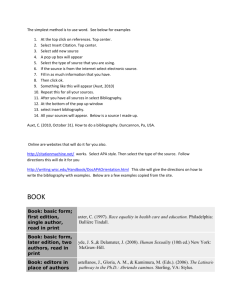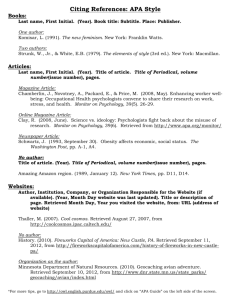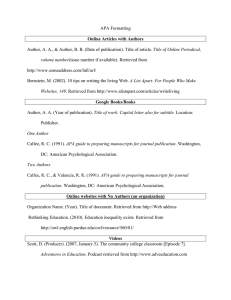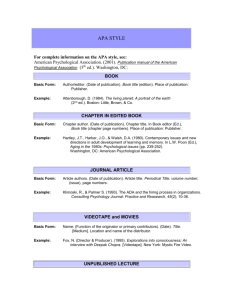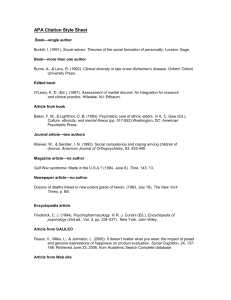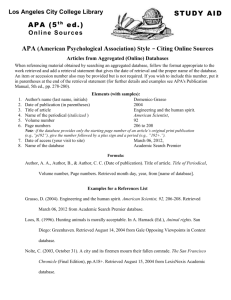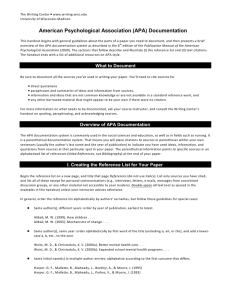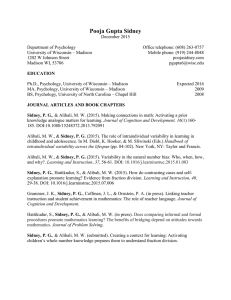American Psychological Association (APA) Documentation
advertisement
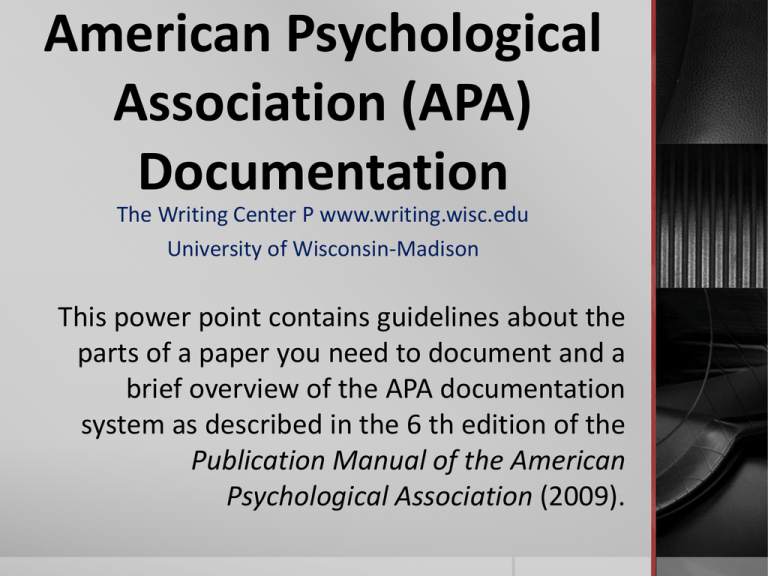
American Psychological Association (APA) Documentation The Writing Center P www.writing.wisc.edu University of Wisconsin-Madison This power point contains guidelines about the parts of a paper you need to document and a brief overview of the APA documentation system as described in the 6 th edition of the Publication Manual of the American Psychological Association (2009). Be sure to document all the sources you’ve used in writing your paper. You’ll need to cite sources for direct quotations paraphrases and summaries of ideas and information from sources information and ideas that are not common knowledge or are not available in a standard reference work any other borrowed material that might appear to be your own if there were no citation Using the APA documentation system means you will place citations to sources in parentheses within your own sentences (usually the author’s last name and the year of publication) to indicate you have used ideas, information, and quotations from sources at that particular spot in your paper. The parenthetical information points to specific sources in an alphabetized list of references (titled References, not Bibliography) at the end of your paper. 1. Place the author(s) and date(s) within parentheses at an appropriate place within or at the end of a sentence: Example: Researchers have studied how children represent mathematical problems (Alibali, Phillips, & Fischer, 2009; Siegler, 1976). 2. Integrate both the author and date into your sentence: Example: In 2009 Alibali, Phillips, and Fischer reported that third- and fourth-grade students improved their problem representation when they were taught the equalize strategy but did not improve their problem representation when they were taught the add-subtract strategy. Begin the reference list on a new page, and title that page References (do not use italics). List only sources you have cited, and list all of these except for personal communications (e.g., interviews, letters, e-mails, messages from discussion groups, or any other material not accessible to your readers). Double-space all text. The sample reference list that follows illustrates the most common types of references. PLEASE NOTE: In your paper, the list of references should be in alphabetical order according to the first author’s last name. The following examples are arranged by type of reference for your Cornell Notes only. 1. Book: basic form; first edition, single author, read in print Baxter, C. (1997). Race equality in health care and education. Philadelphia: Ballière Tindall. 2. Book: basic form, later edition, two authors, read in print Hyde, J. S., & Delamater, J. (2008). Human Psychology (10th ed.). New York: McGraw-Hill. 3. Book: editors in place of authors Castellanos, J., Gloria, A. M., & Kamimura, M. (Eds.). (2006). The Latina/o pathway to the Ph.D. Sterling, VA: Stylus. 4. Brochure [pamphlet]: no date; no author; print Inside these doors: A guidebook of Elfreth’s Alley homes [Brochure]. (n.d). Philadelphia: Elfreth’s Alley Association. 5. Government report, corporate author; read online National Institute of Mental Health. (2009). Anxiety disorders (NIH Publication No.09-3879). Retrieved from National Institute of Mental Health website: http://www.nimh.nih.gov/health/publications/anxietydisorders/nimhanxiety.pdf 6. Chapter in edited work: print Alibali, M. W. (2005). Mechanisms of change in the development of mathematical reasoning. In R. V. Kail (Ed.), Advances in child development and behavior (pp. 79-123). New York: Academic Press. 7. Chapter in edited work: second or later edition; print Curtin, J. J., & Lang, A. R. (2007). Alcohol and emotion: Insights and directives from affective science. In J. Rottenberg & S. L. Johnson (Eds.), Emotion and psychopathology: Bridging affective and clinical science (2nd ed., pp. 191-213). Washington, DC: American Psychological Association. 8. Journal article, basic form; single author; print Alibali, M. W. (1999). How children change their minds: Strategy change can be gradual or abrupt. Developmental Psychology, 35, 127-145. 9. Journal article; two authors; read online from journal website; a webtext; no page numbers Carter, S., & Dunbar-Odom, D. (2009). The converging literacies center: An integrated model for writing programs. Kairos: A Journal of Rhetoric, Technology, and Pedagogy, 14.1. Retrieved from http://kairos.technorhetoric.net/ 10. Magazine article: print Park, A. (2009, Sept. 14). A shot at cancer. Time 174(10), 32-39. 11. Magazine article: read online, found through a database (EBSCO)–do not list the database; list the home page for the magazine Park, A. (2009, Sept. 14). A shot at cancer. Time 174(10), 32-39. Retrieved from www.time.com/ 12. Video or DVD Arledge, E. (Producer & Director). (2009). Autism genes [DVD]. Available from http://www.pbs.org/wgbh/nova/sciencenow/ 13. Newspaper article: read online Barringer, F. (2009, Sept. 14). Hawaii tries green tools in remaking power grid. The New York Times. Retrieved from http://www.nytimes.com 14. Web site: no author, no date of publication. If there is no author, title moves to the first spot. Use retrieval date only because the content at that address likely changes. Research Initiatives. (n.d.). Retrieved January 11, 2007, from MIT, Comparative Media Studies website, http://cms.mit.edu/research/index.php 15. Blog posting Lopez-Duran, N. (2009, August 27). Re: Gender and age differences in the symptomatology of child depression [Web log message]. Retrieved from Child Psychology Research Blog, http://www.child-psych.org/


